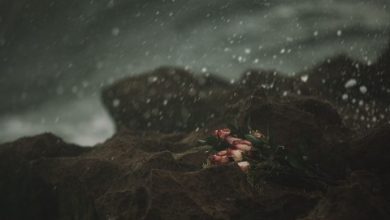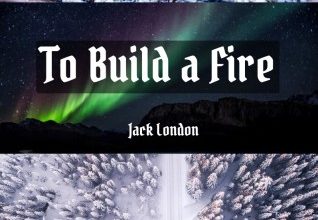“A Mountain Journey” by Howard O’Hagan is a short story written from an omniscient limited third point of view. The story tells the adventure of Dave Conroy, a trapper (a person who traps animals for their fur and meat), as he makes his way from the Snake Indian River trail to the Hoodoo cabin on Hoodoo Creek. On the way when he is descending from the pass he falls into an air hole and his feet and hands suffer frostbite as a result. Conroy however does not stop and continues on his way only to find the cabin burned down when he reaches there. By this time Conroy’s feet and had had been frozen to such an extent that he couldn’t even start a fire. Even then Conroy decided to go to Terrace Creek where there was another cabin. On the way to the Conroy falls from exhaustion and the narrative ends as if Conroy is dying. The story is a realistic depiction of cold mountains where traveling alone is a matter of great courage and skill. Conroy seems to be talented and strong enough to do that yet his desire to get out of the cold snow surpasses his rational judgment which leads to his death. Hagan expresses Conroy’s tale with descriptions that make the reader feel as if they are trapped in the mountains by the burned cabin.
A Mountain Journey | Summary
The story starts with Dave Conroy’s narrative as he arrives at the pass that would lead him to the Hoodoo cabin. He had been climbing from the lower Smokey since the morning and had just reached the pass. He was very tired and he still had to travel five miles further to reach the cabin. He had his pack with him and had carried it out up to the pass. He was remembering the tree he had passed earlier which could have made a nice camping spot where he would not have to worry about sleeping on the snow. According to him when a man was alone he would travel too far and always rush things even though the difference of a day or two would make no difference.
Once Conroy reached the pass the only thing left for him was to go down the slope. Up on the pass, the air was heavy with mist and cold and Conroy was starting to feel abandoned as it had been a long time since he had come across any human establishment. He adjusted the poles and started going down the mountain along with the velocity. The air was sharp and bit at Conroy’s face and as he looked at the scenery the ice suddenly broke under his feet. He fell into the river which cracked by his force and the water seeped into his boots and gloves.
He had fallen into an air hole. His skis had ice on them. Conroy thought he should stop right now, make a fire warm himself, and continue on the journey tomorrow. Already the sun was setting and soon it would be night. He still had to travel three more miles to reach the cabin. But he did not listen to his reasoning and continued to walk on even though he was in pain. When he reached the cabin he was frozen to find the cabin burned down. It had been destroyed by the fire probably caused by a stray match when the previous occupants used it.
The next cabin was located at Blue Creek, eighteen miles from his current location. He knew that he did not have enough strength to go there. He decided to stay the night there and thought of using the wood from the cabin to start a fire. As he took out the matchbox to do that, he realized that he couldn’t feel his hands and legs. They had been frozen to such an extent that he could not even feel if he had them anymore. He tried to strike the matchstick but he failed to do that. He always believed that mountain travel was not dangerous as long as a man knew how to take care of himself. It was only his fault that he froze himself. As stood there trying to bring some warmth to his hands and feet he remembered about Duncan Macdonald who had walked thirty miles to the railroad on frozen feet only to have them amputated by the doctor.
Conroy was however not ready to give up and decide that his feet and hands were no longer frozen. He was desperate to such an extent that he thought of even setting the whole forest ablaze just to get some warmth. But his hands were not cooperating with him. Finally, Conroy understood the gravity of the situation and thought about his only chance. The railroad was eighty miles away, a journey of four days, something that Conroy could not cross. Another option was the Terrace Creek located through a pass into the Moose River. There Frank MacMoran, a trapper, had his cabin and could shelter him.
He crossed the river and trudged towards the slope that would lead him to the Moose. He climbed up the peak passing through the forest of timers. By this time night was fast approaching and he decided to rest on the ground for just a few minutes. But by the time he woke up, he was lying on the ground at night. Above him, in the moonlight, the mountains stretched endlessly and Conroy still had to travel six hundred miles more. Conroy tried to get up but his strength failed him and he decided to rest for a bit more.
When he finally woke up it was already morning. Conroy was covered in snow which he could not remove from himself due to his weakness. He was so weak that he started to hallucinate. He saw a cabin and heard the river streaming down. Then he remembered his predicament and started hoping that someone would come for him. He even believed that they were just by the Hoodoo cabin and would come for him. However, no one came and now the sum was now starting to hurt him he felt the light fading.
A Mountain Journey | Analysis
The story has been written in the style of realistic fiction as it describes the dangerous journey taken by David Conroy. The story’s main focus is the harsh conditions of the weather as Conroy tries his best to win against them. However, due to Conroy’s lack of critical thinking, he ends up hurting himself and ends up lying in the snow helplessly while his strength fades away from him.
The protagonist of the story is Dave Conroy and the antagonist is the weather. Conroy tries to win against it his entire journey but eventually, he has to give in as he is unable to move from exhaustion. Hence the story uses the weather as a lesson to show the might of nature and that man is helpless against it. Conroy tries to fight as long as he can but eventually, he has to give in to it as he is trapped in his hallucinations.
Hagan has written the story in a very descriptive style where it feels as if one is reading a poem about mountain landscapes. The detailed explanation and natural imagery provide the reader with a feeling as if they were themselves present there and traveling along Conroy. In this way, the story becomes much more interactive even though it never provides a clear ending.
The story has used plenty of foreshadowing and plot twists which adds tension to the story. This makes the story more like a travel vlog where the main character, here Dave Conroy, goes along his way showing the scenery to the readers along with him. The open-ended ending of the story indicates that perhaps the author is trying to tell his readers to anticipate the resolution themselves. This provides the story with various interpretations which adds to the beauty of it as with this kind of ending for someone maybe Conroy survived and help came for him or for someone else he was killed. In this, the technique of using an incomplete ending adds to the richness of the story.
A Mountain Journey | Themes
The main theme of this story is man versus nature as well as man versus self. Dave Conroy is an experienced traveler and trapper who has made many hikes in the mountains. He is skilled enough to know which paths he has to take to reach the different cabins located throughout the trail. Despite knowing all of this he manages to lose his way when he tries to reach the Terrace Creek. This is because Conroy was so focused on getting warmth that even when he fell into an air hole and was frozen he chose not to stop and rest but continued on his way. He simply assumed that his hands and feet were not affected by the cold even though later he could not even feel them anymore. This shows Conroy’s arrogance towards nature where he wanted to prove that he could maneuver around the mountain with his knowledge alone. However, he eventually loses to nature as he reaches the Hoodoo cabin only to find it completely burned down. In this sense, the mountains become symbolic of the power of nature and the way human beings are powerless against it.
The story also focuses on the conflict that Conroy has with himself. From the very beginning even though he knew he should have stopped by the tree to rest there, he ignored his reasoning himself and continued onward. After this, he fell into a stream, and even though the most rational thing to do at that time was to set camp there for the night he never listened to the voice in his head and instead went on. Only did he reached the cabin did he realize his mistake but by that time it was too late and the only option he had left was to continue forward otherwise he would freeze to death.
Hence the story focuses on the forces of nature and man’s incapability to fight them or tame them.
A Mountain Journey | Character Sketch
The main character of this story is Dave Conroy who struggles against the cold snowy winds as he finds his way across the mountains. He is a professional trapper who has been to the mountains countless times yet his pride makes him unable to say no even though he can see that the hike will be difficult for him like the time he fell into an air hole and his hands and feet were frozen. This makes Conroy a gullible person who cannot say no in case of his ego which ends up in his dying on his way to the Terrace Creek.
A Mountain Journey | Literary devices
The story has several literal devices like simile where Hagan describes the snow as “white and soft as flour,” also in the instance where he compares tea to wine “tea red and strong as rum”. He also used personification to describe the mist as it covered the whole slope of the mountain, “Mist, like the shadow of universal darkness on the treeless summit, moved about him, searched every crevice of the mountain land, roamed in great billows, formed in the blindness and suffering of eternal homelessness.” He even personified the tree Conroy had passed by earlier which foreshadows his fate as he walks along to find Hoodoo cabin by describing it as “That tree, like a strong and lonely woman, called to his weary body to stop.” By using those figures of speech the story becomes much more interesting.
The story is a great example of being courageous in the face of hardships but at the same time, it also highlights the way the limit to one should endure hardships otherwise it ends up becoming a source of problems instead of a solution.





